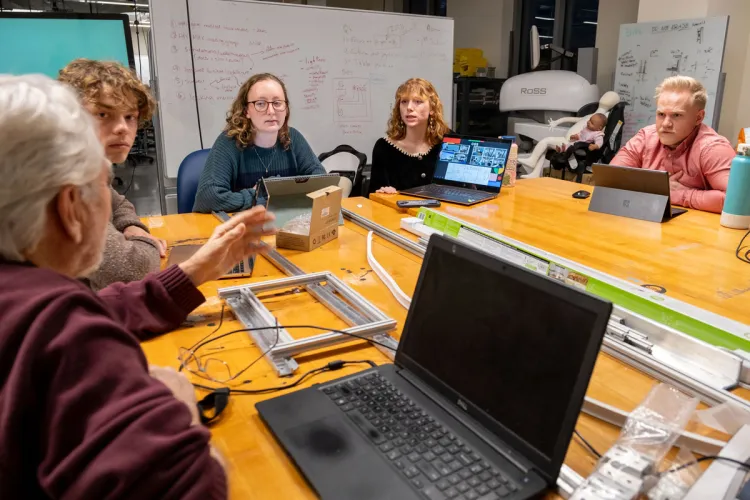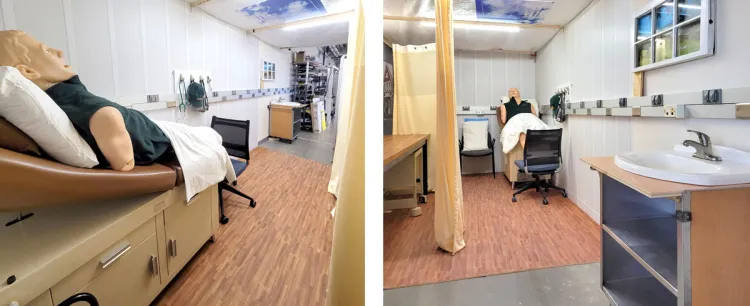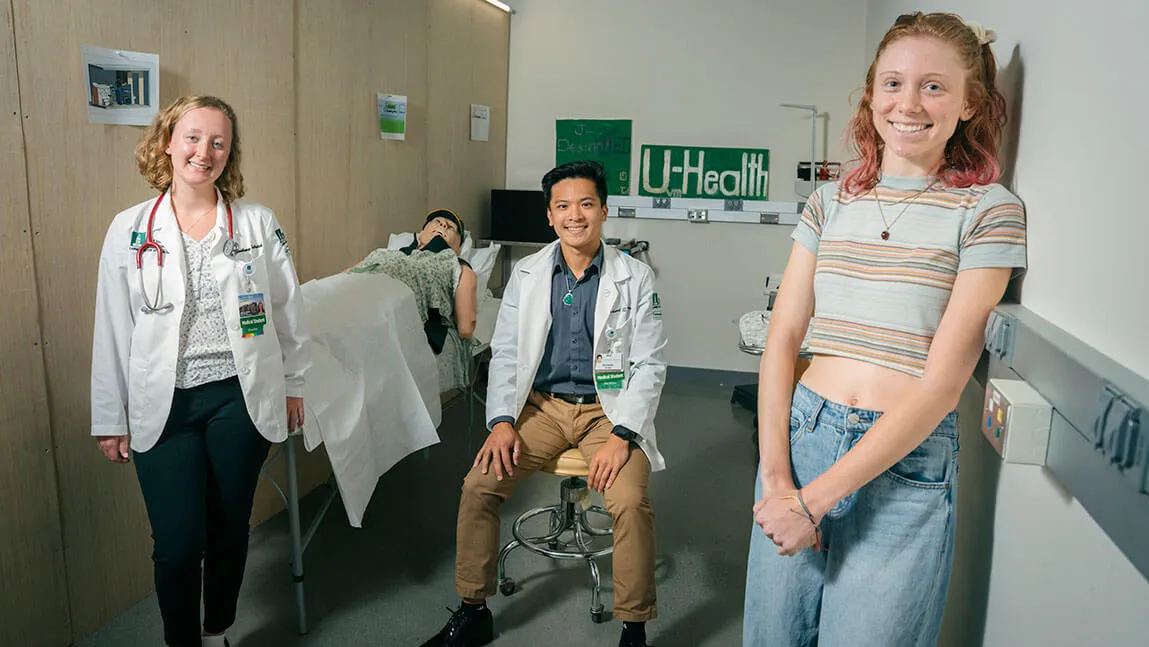With nearly 65% of its population living in rural areas, Vermont is considered the most rural state in the nation. Delivering high-quality care to these communities has always been a top priority for The University of Vermont Health Network and a new partnership with UVM’s Center for Biomedical Innovation (CBI) aims to develop a creative and scalable solution to that complex mission.
The potential of an innovative new healthcare delivery vehicle—described as the Omni-mission Health Truck—featuring swappable, mission-specific modules that can be quickly deployed to rural communities has resulted in a novel technology collaboration agreement between the UVM Health Network and UVM’s biomedical engineering design hub.
Located within the College of Engineering and Mathematical Sciences (CEMS), the CBI brings together unique expertise from faculty and students from across campus including the Grossman School of Business, the College of Nursing and Health Sciences, and the Larner College of Medicine. With a focus on rural healthcare innovation, the CBI serves as a leader, resource, and partner in the design, development, and testing of health-related devices and systems.
“The vision behind creating the CBI was to be able to have engineers enable better healthcare practice,” said CEMS’s Dean Linda S. Schadler. “This agreement to co-develop a multi-use healthcare vehicle is a perfect example of engineers and physicians working together to create a solution that will deliver better healthcare to rural Vermonters.”
The concept of developing a truck with Lego-like payloads to bring healthcare to rural Vermonters had its origin two years ago in a lucky convergence of spontaneous ideas generated by CBI, UVM Health Network, and a pair of students in the Larner College of Medicine at the University of Vermont.

At the time, the newly formed CBI was working with VermontCARES, a state agency focused on harm reduction and HIV-related care, to brainstorm possible new ways their mobile service vans could be utilized. “We thought something new and broader could be done with these vehicles when the idea of creating a vehicle that was adaptable to any mission surfaced,” said Mike Rosen, CBI’s director.
At the same time, physicians at The University of Vermont Medical Center (UVMMC) were exploring the use of mobile-based platforms to meet the healthcare needs of vulnerable populations with a particular focus on providing care to infectious disease patients and improving the options for postnatal care for mothers who are in rural areas.
“We were proactively expanding our mobile health platform to address the needs of high-risk patients and highly vulnerable patients to try to minimize and, in some cases, prevent the need for hospitalizations,” said UVM Health Network’s Chief Medical Officer David Clauss.
These ideas came together during the summer of 2022 in the work of two Larner Medical School students, Lindsay Aldrich ’25 and Richard Vuong ’25. Aldrich and Vuong received a competitive fellowship to develop their idea of a mobile maternal health clinic from the Gold Foundation, an organization whose funding priorities include those that address health inequities with a focus on underserved communities.
The project, titled U-Health: Expanding Healthcare Access for Postpartum Women in Rural Vermont with a Mobile Health Vehicle, looked to bring the doctor’s office to new mothers through a new mobile health vehicle to ensure they receive critical postpartum care and meet other essential appointments.
Partnering with Rosen and his engineering team at the CBI, the medical students recruited support from a pair of Larner faculty: Dr. Jill Warrington, a pathologist and the laboratory director at the Vermont Department of Health, and Dr. Marjorie Meyer, the director of Maternal-Fetal Medicine at UVM Medical Center.
The group of collaborators initially coined the project “U-Health” after being inspired by the potential of a basic U-Haul moving truck which would then be outfitted with the furnishings and equipment necessary to deliver on its mission which, in that case, was postpartum care.
In time the potential of the truck evolved with the final objective of the project reading, “U-Health is a project that aims to design a mobile health vehicle with easily swappable payloads that brings healthcare directly to Vermonters—the first mission is to build a payload targeting postpartum women in rural Vermont.”
During CBI’s engineering design process, early floor plans for the truck were prepared for the initial mission using computer-aided design (CAD) software that eventually led to a full-size mock-up of the payload box being constructed in CBI’s studio. The structure allows the team to start to identify the questions that would need to be answered for a multi-use vehicle including internal layout, entry/exit points, required furnishings and equipment, and users’ operational requirements. A unique engineering consideration is the ongoing development of a highly adaptable payload mounting system for secure positioning and rapid exchange of varied mission-driven furnishings and equipment.

Integral to that design process, Rosen said, is considering the unique implications of deploying a vehicle that could carry sensitive medical equipment over Vermont’s rural network of unpaved back roads. “Shielding equipment from vibration is just one of the many sophisticated engineering challenges we might need to address,” said Rosen. “Our first step is to create a multi-disciplinary team that can solve these problems as they arise.”
Rosen, who has worked in the biomedical engineering field for nearly 60 years—both in medical and academic institutions—said that once the initial deployment priorities are set by the Health Network team, it will be essential to run a series of authentic simulations in the studio’s truck mock-up to confirm dimensions, specifications, layout, and outfitting.
“We are delighted that the unique design and engineering capabilities of the CBI have been recognized by the UVMHN as a valuable resource,” said Rosen. “This partnership presents an excellent opportunity for our students to work on complex problems driven by urgent regional needs.”
As a veteran emergency room physician, Clauss sees future deployments moving beyond direct patient care to include educational projects that could make extended use of the multi-use vehicle.
“We have interprofessional teams in our network of emergency departments who are in the process of building a system to do very realistic simulation training of high acuity, low occurrence events in our small rural emergency departments,” he said. “We can facilitate simulation training in real-time with all the equipment on hand at these more remote sites and raise the level of care that these teams can provide in low resource settings.”
All these potential deployments arrive at the heart of the project, to develop a multi-use healthcare delivery vehicle that is not limited to one specific purpose. Both Rosen and Clauss see the potential of developing a sort of modular catalog of furnishing and equipment where users could specify the specific payload required for their unique deployment. If the desired component does not exist, the CBI team will design and engineer the required equipment allowing the catalog to grow over time.
The ongoing collaborative potential of the project aligns well with Schadler’s vision for the CBI, “When working with us, our partners know they are getting access to professional engineers and student engineers to help deliver innovative solutions to complex problems,” she said. “At the same time, they are helping drive the educational mission of students who will be the next leaders in these fields who will embrace this interdisciplinary focus.”
